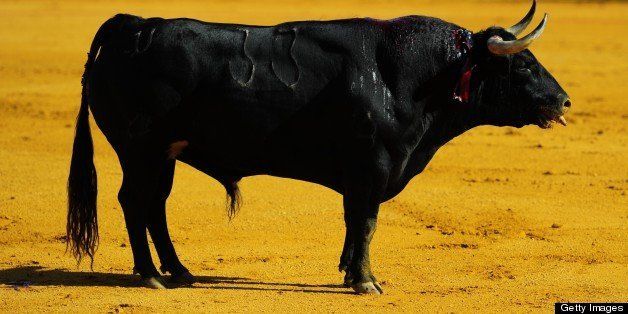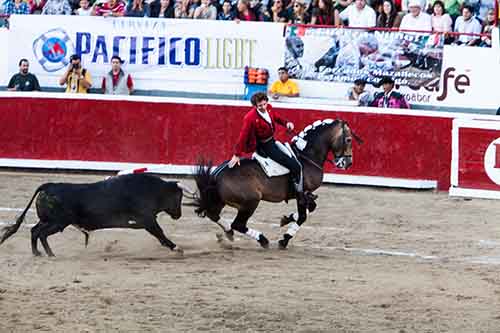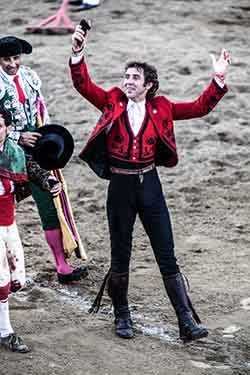
I didn't expect to spend my last afternoon in Mazatlan at a bullfight. Not this girl. The plan was to lie on the beach in a sun-induced stupor, a day alone with my thoughts. But there it was on the wall, the poster pasted at eye-level, two-inch-high letters blaring "Bullfight on Sunday." A swirl of browns and oranges, the illustration -- a blurry over-painted photo -- depicted a man on horseback leaning so far out of his saddle toward an angry bull that a trampling seemed inevitable.
Now, if the photo had been of an ordinary matador I might have blown it off. Gold-embroidered jacket, red cape, ballet slippers, sharp sword, ho hum. But a man on horseback, head-to-head with an angry bull? That got the juices flowing and with them, the adrenaline. It was the oh-so-familiar tug of war, the battle between fight and flight, between want-to and shouldn't. It was the way you feel when an ambulance suddenly flashes in and out of your rear view mirror and passes you, sirens screaming.
Not me, you tell yourself, I'm not an ambulance chaser, a blood-sucking ghoul. This is immediately followed, by, "What's the buzz? I've got to know!" And so, when Sunday afternoon rolled around, there I was in the Plaza de Toros, one of a packed crowd of men and women, girls and boys excited but patiently waiting for the big moment.
Then the trumpets blared, the crowd roared and the first bull tore into the arena, big head, curved pointed horns, shoulder muscles rippling, hooves tearing up the dirt as he circled the ring. Spotting three helpers -- capeadores -- stepping out from behind a guard fence to shake their capes and attract his attention, he lowered his head and charged full speed into the fence. Wham, bang, crunch! as 2,000 pounds of bad-tempered testosterone skewered the fence, horns raking the boards until one of them fell off.
Of course, he was enraged. For four years he'd had the run of the ranch, roaming grassy pastures, gorging on muscle-building meals, sparring with other young bulls and relishing the satisfaction of driving away the occasional horseback rider come to provoke him into an outburst and test his mettle. And now, entering the ring, was another annoying man on horseback!
Meanwhile I, from my seat in the stands, was as surprised as the bull. For instead of a matador, the fighter entering the ring was the world-famous rejoneador, Pablo Hermosa de Mendoza, the man on the poster. An equestrian bullfighter and practitioner of the ancient tradition of bull-fighting on horseback, the charismatic Hermosa travels with a string of high-strung, trained Lusitano horses -- necks arched, coats shining, hooves polished, tails knotted, manes woven with ribbons. And once a year he comes to Mazatlan, where he's a guaranteed sell-out.
Whether or not you condone bullfighting, you can't tear your eyes away as Hermosa circles the ring, his horse prancing sideways, nerves a-jangle. Then he gets down to business, teasing the bull until it charges, then wheeling away. Leaning and turning, he circles the ring then doubles back as the bull, its horns just inches away, tries to gore the horse. Whirling, spinning, leaping, taunting, Hermosa is a tour de force, wearing down the bull, impressing riders with his horsemanship and astonishing everyone else with the horses' acrobatic dexterity (they are every bit as impressive as the Lipizzaner stallions). Handsome, brave, daring, Hermosa molds the crowd into a single-brained cheering, gasping, groaning, clapping, handkerchief-waving, adoring mass.
Four bulls entered the ring that afternoon, each more aggressive than the ones before it. Hermosa was matched with two; the matador, notable only for an especially mediocre performance, faced the other two. As expected, each bull met the expected fate, Hermosa's bulls dying quickly, the matador's more painfully. Was the bullfight cruel? Animal activists say it is. But is raising cattle for food any less cruel? Castrated as calves, typically at two months of age, steers raised for meat live one, maybe two years before they're fattened up on corn (a grain they can't digest) and butchered. Bullfight supporters make the case that a bull raised wild and free, even if destined for the bullring, lives better and longer.
I'm heading to the BIG M again, for the next Mardi Gras celebration, touted as the world's third largest after Rio and New Orleans. Would I go to the bullfights again, when I'm there in Mazatlan? Maybe. But only if those magical horses -- and their owner-- are on the poster.


After Spain, Mexico is the country with the greatest number of bullrings and fans, with bullfights held on Sundays from October through April. In Spain, where the region of Catalonia has banned the sport, the Spanish Parliament is currently considering whether to strike down the ban and is debating legislation to protect bullfighting as a national cultural heritage.
Photos and video courtesy of Steve Haggerty.